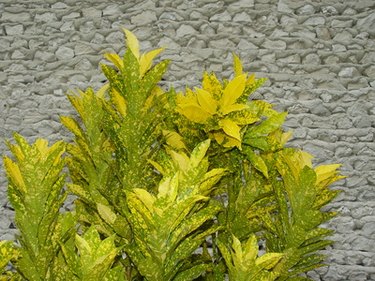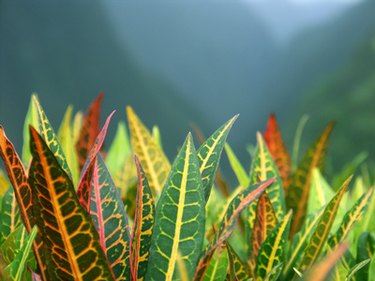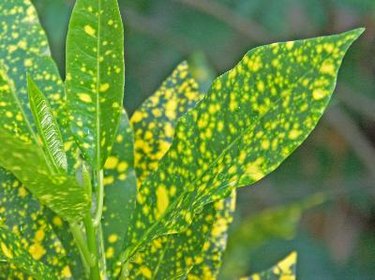
Grown as colorful houseplants or outdoors as shrubs in tropical, frost-free landscapes, crotons (Codiaeum variegatum) comprise a diverse collection of cultivars. The plants display variably colored leaves and shapes -- from threadlike straps to lobed, oaklike or large and oval. Improper care of crotons, both indoors and out, contributes to premature leaf drop. As a houseplant, the croton isn't the easiest plant to grow, since it needs specific and constant growing conditions.
Proper Growing Conditions
Video of the Day

Crotons appreciate bright light, even partial to full sun exposures, to produce the most colorful leaves and obtain food from photosynthesis. The more intense natural light from spring to fall promotes growth, so freely water and occasionally fertilize. During this time frame, high ambient humidity is best. From fall to spring when temperatures are cooler and light less intense, stop fertilization and reduce watering to keep soil barely moist. Indoors, the croton must be in direct sun rays from a southern or western window. Wavering from these seasonal conditions can lead to less than happy plants.
Video of the Day
Causes of Leaf Drop
Drafts and fluctuating temperatures cause leaf drop in crotons, according to the American Horticultural Society's "A-Z Encyclopedia of Garden Plants." In December, the start of winter, outdoor crotons may naturally shed oldest leaves as temperatures get chilly or they are stressed from overly wet soils. Indoors, lower light levels, heating vent drafts, very low humidity or proximity to a cold window pane also can cause irregular drop of the oldest and lowermost leaves on branches.
Prevention/Solution

Outdoors, there's little you can do to correct weather conditions, but in the cooler, shorter days of December, make sure you're not overwatering plants in the garden. Check automatic irrigation and modify sprinkler head ranges or reset the timing frequency. Let natural rainfall provide the moisture to crotons over the winter. Indoors, expect some leaf drop every fall and winter on crotons. Avoid placing them in dim rooms and by northern window exposures. Do not abruptly change location of houseplants, as both varying light and temperature levels will continue to cause further leaf drop. Rotate plants 90 degrees weekly so all sides of the plant receive bright light over the winter. Also make sure containers are not overwatered and roots sitting in water in a basin. Also cease fertilization. If the floor is cold, lift the croton and rest it on a plank of wood or rack rather than resting directly on chilly concrete.
Rejuvenating Leggy Plants
Crotons may continue to shed more leaves across the winter in the house or outdoors if conditions aren't perfect. To rejuvenate old or leggy plants, prune crotons back hard in mid to late spring so they produce lush, healthy growth over the warm summer. Water and lightly fertilize in warm weather, but follow cultural conditions closely for the croton once winter again approaches.